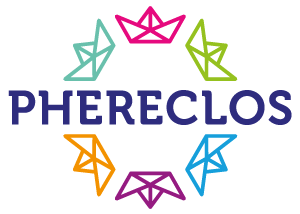
It’s a matter of relevance – What happened in the last Open Schooling Inspiration session?
The 8th Inspiration Session of the OStogether network was organized by the PHERECLOS project and dedicated to the question: “How to create a closer connection between the research and the education community?”
We selected the session topic because PHERECLOS has its roots in the idea and learnings of Children’s Universities, which are essentially science engagement programs, to bring young people in contact with science, research and the concept of Higher Education. Usually organized by universities, via widening participation or outreach programmes, the third mission unit, or the education department, Children’s Universities started in many cases as science communication and knowledge providers. As an evolutionary step in most programs, the aspect of respectful engagement and socially-inclusive targeting is a fundamental part of the mission. Working together with social centers, municipalities, sponsoring partners, and many other interested parties, Children’s Universities often act as intermediaries between different stakeholders in society. After 20 years of experience and many good practice examples how to organize science engagement on a child-focused individual level the PHERECLOS project is exploring Open Schooling as a concept to facilitate links between science and schools. For that reason, we invited for the Inspiration Session speakers who were able to explore different perspectives and talk about the challenges to establish an equally beneficial communication between teachers, scientists and young people.
Marika Cieslinski of the Austrian Agency for Education and Internationalization presented, as our guest speaker, the strategic considerations and practical experiences of the Young Science initiative ( https://youngscience.at ), a rather unique collection of initiatives to support schools and pupils to take part in science and research. This includes a platform of young science ambassadors for in-house school visits, to fully fledged citizen science projects, funded with a special grant program. This feeds into the mandatory pre-university project work that is part of the ‘maturity diploma’ as a university entrance precondition. That way school students in Austria receive additional input for topic selection and additional support from university researchers.
Very useful for researchers and school staff alike in this context is a guide for “Citizen Science in School” with tips and a checklist for successful planning and implementation in schools (download here – unfortunately in German only).
In a more panel like setting, the session continued with even more practical examples of collaboration where we invited people in the sphere of the PHERECLOS project to contribute with statements about individual learnings. Kevin Wolz, a PhD student from the Sissa University in Trieste, highlighted the importance of discovering the spark of interest that motivates – on a personal level, as a researcher, but also to transmit one’s own enthusiasm to others. For him it is also very important to have a high level of creative freedom in terms of what and how to present in science engagement programs, because it provides new purpose and motivation. Engagement in school – university programs also offer opportunities to get external viewpoints on your own research.
Petra Feldhofer Mahmoudian reported about the potential of cooperation between schools and scientists from her perspective as a primary school head teacher in Vienna. Due to the ongoing Open Schooling project within a Local Education Cluster of the PHERECLOS project, school pupils and teachers had the opportunity to receive first-hand information about open issues and questions that affect them in daily life. The most urgent topics to address were of course Coronavirus and the war in Ukraine, and how to deal with and understand the current situation. Because of the establishment of a direct university link, it’s now easier for the school to find the necessary information to address these questions in their lessons. Even more, the close collaboration between the teachers and scientists and communication experts empowered the teachers to tackle such complex subjects in class in a better-informed way and gave them self-confidence to talk more broadly about science and research.
Many science outreach programs rely on the motivation and enthusiasm of ‘a few’ committed individual scientists, suggested Susanne Schramm, from the Vienna University Children’s Office. What is often missing is a supporting administrative structure to relieve the people who are doing the actual outreach activity from administrative burdens such as setting up the timetables and communicating with schoolteachers about logistics, etc. Funding for programs outside of the big university cities is necessary, because young people in rural areas are very much disadvantaged regarding access to science outreach programs and lack relevant role models for their future educational decisions. According to the interviews with researchers from the university already involved in outreach, Susanne reported, that they miss well-established networks and the opportunity to contact colleagues to share experiences in science communication (so can feel quite isolated when doing these activities). Even more, as most of the practitioners consider it more sustainable, if such projects do not start over and over again, but schools and researchers alike could build on the existing experiences and receive regular offers to integrate in their work and time management.
Paola Rodari from the Sissa Medialab in Trieste also highlighted the significance of supporting structures for outreach within universities to train and organize the programs. It is important to have experts to establish a culture of science communication also to trigger organizational change. Change is also highly triggered by the enthusiasm of young researchers, who influence at the end also the well-established researchers and vice-versa as the programs create new communities of people who did not collaborate before within the university. Training in science communication is a strong incentive for scientists, and Paola’s advice is that all universities should establish this as a permanent offer.
Paola also shared a very important aspect according to her experience and understanding of science communication, which is the importance of relevance. There is a difference between simplicity and relevance. The big question is “what” are we doing in research and “why” and how is this relevant to oneself and to the audience.
Finally, Phil Smith from the Teacher Scientist Network introduced the participants to 25 years of actually doing this stuff – partnering teachers & scientists – in the UK. He shared very interesting results from a Royal Society survey (2006) about the attitudes and practice among scientists with regard to science communication and public engagement. This included negative aspects for scientists that need to be countered, e.g. several researchers highlighted that public engagement activity was seen by their peers as ‘bad for their career.’ with a further message that emerged was that public engagement was done by those who were ‘not good enough’ for an academic career.” (Science Communication | Royal Society) Phil also explored the relationship between teachers and scientists and the different roles they fulfill when working in partnership. In trying to unify thoughts from the previous speakers he endorsed the importance of coordinators for such programmes (tackling the logistics) and ensuring everyone is ‘on the same page’ before trying to work together addressing the teachers needs in a truly bottom-up way.
Author: Cyril Dworsky
